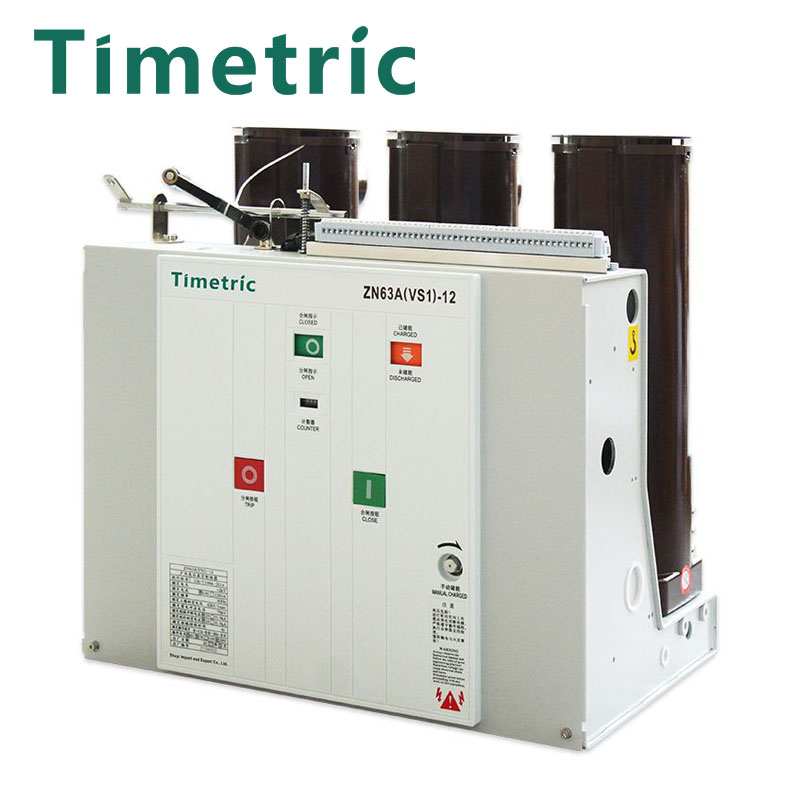What are the overvoltage hazards and types of VS1 vacuum circuit breaker?
2023-11-14
Speaking of this problem, let’s first understand what over voltage is: over voltage refers to the long-term voltage fluctuation phenomenon in which the root mean square value of the AC voltage under power frequency increases, exceeds 10% of the rated value, and lasts for more than 1 minute; The appearance of voltage is usually the result of a moment of load switching. Occurs when inductive or capacitive loads are connected or disconnected during normal use. What are its occurrences?
over voltage is divided into two categories: external over voltage and internal over voltage.
External over voltage is also called lightning over voltage and atmospheric over voltage. Caused by thunderclouds in the atmosphere discharging electricity to the ground. It is divided into two types: direct lightning over voltage and induced lightning over voltage. The duration of lightning over voltage is about tens of microseconds and has pulse characteristics, so it is often called lightning shock wave. Direct lightning over voltage is the over voltage that occurs when lightning directly strikes the conductive part of electrical equipment. A lightning strike that strikes a live conductor, such as an overhead transmission line conductor, is called a direct lightning strike. Lightning strikes a conductor that is normally grounded, such as a transmission line tower, causing the potential to rise and then discharges the charged conductor, which is called a counterattack. The over voltage amplitude of a direct lightning strike can reach millions of volts, which will destroy the insulation of electrical facilities and cause short circuit and ground faults. Induced lightning over voltage is the over voltage induced on electrical equipment (including secondary equipment and communication equipment) that has not been directly struck by lightning due to the rapid changes in the space electromagnetic field during the discharge process when lightning strikes the ground near electrical equipment. Therefore, overhead transmission lines need to be protected by lightning devices and grounding devices. The lightning protection capability of transmission lines is usually expressed by the line lightning resistance level and lightning tripping rate.
Internal over voltage: over voltage caused by changes in the internal operation mode of the power system. There are transient over voltage, operating over voltage and resonance over voltage. Transient over voltage is an over voltage that occurs when the power system reaches a certain temporary stability after going through a transition process due to the operation of a circuit breaker or the occurrence of a short circuit fault. It is also called an increase in power frequency voltage. Common ones include: ① No-load long-line capacitance effect (Ferranti effect). Under the action of industrial frequency power supply, due to the accumulation of capacitance effect on long-distance no-load lines, the voltage distribution along the line is unequal, with the terminal voltage being the highest. ②Asymmetric short circuit to ground. When phase a of a three-phase transmission line is short-circuited and grounded, the voltage on phases b and c will increase. ③Load shedding over voltage. When the transmission line is forced to shed the load suddenly due to a fault, the over voltage is caused because the power supply electromotive force has not been automatically adjusted in time. Operating over voltage is an over voltage with rapid attenuation and short duration caused by circuit breaker operation or sudden short circuit. Common ones are: ① no-load line closing and reclosing. ② Cut off the over voltage of the no-load line. ③ Cut off the over voltage of the no-load transformer. ④Arc ground over voltage. Resonance over voltage is an over voltage caused by energy storage components such as inductors and capacitors in power systems resonating with the power frequency under certain wiring methods. Generally divided according to the cause: ①Linear resonance over voltage. ② Ferromagnetic resonance over voltage. ③Parametric resonance over voltage.
During the use of the VS1 vacuum circuit breaker, various external faults may cause damage or burnout of the vacuum circuit breaker. over voltage is one of them. At the same time, the over voltage that occurs during the use of the vs1 vacuum circuit breaker will seriously affect the power equipment. The insulation brings harm, so corresponding measures should be taken according to the type of over voltage to reduce the occurrence of over voltage and reduce the value of over voltage. In addition to the problems with the manufacturing process of vs1 vacuum circuit breaker, protective devices can be installed to change load parameters to achieve the purpose.
The capacitive protection of vs1 vacuum circuit breaker connects a capacitor in parallel with the inductive load end, which can effectively reduce the load impedance, thereby reducing the amplitude of the interception over voltage, and also slow down the leading edge steepness of the over voltage. This not only protects the inductive load from The damage caused by interception over voltage can also reduce the harm caused by repeated reignition over voltage to the motor insulation. The vs1 vacuum circuit breaker is connected to the transformer or motor with a cable. Since the cable has a large distributed capacitance, its function is equivalent to a parallel capacitor, and the effect is very good.
The resistance-capacitance protection of the vs1 vacuum circuit breaker connects the resistor R and the capacitor C in series as a protection element and connects them in parallel at the load incoming line end to form an RC over voltage suppressor. The capacitor can not only slow down the rise steepness of the over voltage, but also reduce the wave impedance of the load, thereby reducing the interception over voltage. The function of the resistor is: when current cut-off occurs, its presence increases the attenuation coefficient of the high-frequency discharge circuit, which can reduce the number of re-ignitions and multiple re-ignition over voltages, and can even effectively prevent its occurrence. Using an RC suppressor to protect loads such as motors has the best effect. The over voltage that occurs during the use of vs1 vacuum circuit breaker brings harm to the insulation of power equipment. Therefore, corresponding measures should be taken according to the type of over voltage to reduce the occurrence of over voltage and reduce the value of over voltage. In addition to the problems with the manufacturing process of the vs1 vacuum circuit breaker, protection devices can be installed to change the load parameters to achieve the purpose.
In the next article, we will focus on specific methods to deal with over voltage.





